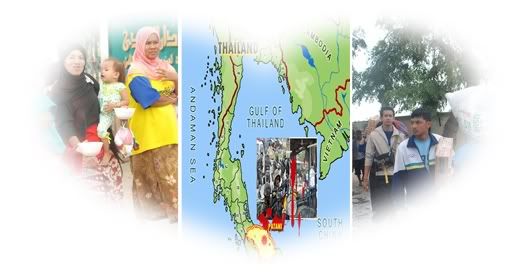Introduction
The continuing unrest in Southern Thailand since January 2004 to present day has resulted in more than 3,611 deaths and injured about 6,073 persons
Malaysian PM readies for visit to deep South
Malaysian Prime Minister Najib Razak will visit Bangkok in early December before joining Prime Minister Abhisit Vejjajiva on a tour of the three southernmost provinces
Muslim Malay of Patani
The Patani Malays or Muslim Malay of Patani are living primarily in Patani Raya, the southern provinces of Thailand..
The Ancient City of Yarang
The ancient city of Yarang was one of the biggest communities in the early historical period in the south of Thailand and believed to be the location of the ancient domain name “ Langkasuka”
Anatomy of a Forgotten Conflict
The only long-term solution combines firm action against the perpetrators of violence and "substantive autonomy" for the three southernmost provinces
Friday, April 29, 2011
Yala Car Bomb : Weak Excuse
Sunday, April 17, 2011
Southern Border Provinces Administration Act
The Act was approved by the National Assembly in November 2010 and took effect on 30 December 2010 after it was published in the Royal Gazette. It covers all districts in the five southern border provinces, namely Pattani, Yala, Narathiwat, Songkhla, and Satun.
 |
| Does SBPAC allow real freedom of Conscience to the people? |
According to the new Act, SBPAC is a special government unit under the direct supervision of the Prime Minister and is not under the jurisdiction of any particular government agency. The Secretary-General of SBPAC, a senior civil servant equivalent to the status of a permanent secretary, serves as chief of this organization.
First established in 1981, SBPAC was disbanded in 2002 but was later revived in 2006. The Abhisit Vejjajiva administration proposed a bill on the restructuring of SBPAC, which received Cabinet approval in October 2009. The objective was to improve the integration of work in various agencies to develop the southern border provinces and tackle problems there effectively in a systematic manner. The strength of this law is that there will be unity in operation and evaluation, starting from the policy-making level to the implementation level, with the participation of all relevant sectors.
Under the Southern Bborder Provinces Administration Act, the Office of the National Security Council will work out administration and development policies to be submitted to the National Security Council and the Cabinet for approval. These policies will be revised every three years, or before three years, depending on necessity and the evolving situation. These policies will take into consideration local culture, religion, history, and way of life. Also participating in giving ideas and suggestions for the policies will be representatives from the public and private sectors, civil society, members of the media, religious leaders, and local wise men, known as prat chao ban. These people are members of the provincial administration and development advisory council.
 |
| Does Poverty the main cause of conflict south? |
The Southern Border Provinces Development Strategy Committee, chaired by the Prime Minister, will approve the strategies, projects, and budget allocations to support development in the southern border provinces. The committee consists of political office holders and permanent government officials, as well as representatives of civil society and other organizations. Permanent government officials on this committee include the Secretary-General of the Office of the National Economic and Social Development Board, the Secretary-General of the Office of the National Security Council, the Budget Director of the Bureau of the Budget, the Secretary-General of the Internal Security Operation Command, and governors of the southern border provinces.
The Southern Border Provinces Development Strategy Committee will meet on January 24, when the Prime Minister will hold a briefing on the policies and operations of the committee and SBPAC in its new structure.
 |
| Does New SBPAC change the situation? |
Tuesday, April 12, 2011
Anatomy of a Forgotten Conflict
 |
| Conflict South: More time more deaths |

Monday, April 11, 2011
The Ancient City of Yarang
 For the shape of ancient city of Yarang, it was estimated that the city’s plan was big in an oval shape covering nine square kilometers . It was the city which built overlappingly and consisted of three cities connected to each other from the area of Tambon Wat to the north in the area of Tambon Yarang which consisted of :-
For the shape of ancient city of Yarang, it was estimated that the city’s plan was big in an oval shape covering nine square kilometers . It was the city which built overlappingly and consisted of three cities connected to each other from the area of Tambon Wat to the north in the area of Tambon Yarang which consisted of :- |
| The Base of Buddhist Pagoda Excavated at Baan Jalek No. 3 |
 |
Muslim Malay of Patani
| |||||||||||||||||||||||||||||||||||||||||||||||||||||||||||||||||||||||||||||||||||||||||||||||||||||||||||||||||||||||||||||||||||||||






















